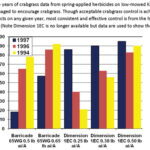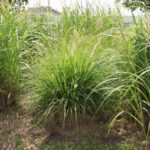Zac Reicher

Calculating the pounds of fertilizer to apply
There are literally thousands of fertilizers and fertilizer/pesticide combinations available to homeowners and professionals. Therefore, we can’t recommend how many pounds of a specific fertilizer to apply, but rather we must recommend fertilization rates in pounds of nitrogen per thousand square feet or lbs N/1000ft2. You can use our fertilizer calculator at http://www.agry.purdue.edu/turf/fertcalc/Fertilization%20calc.html or you can use […]
Professionals Only: Premergence herbicide strategies
As spring is closing in, we are fielding a number of questions four major questions right now: Which preemergence herbide to use? That one is pretty easy. We have only three active ingredients relatively easily available and they are dithiopyr, pendimethalin, and prodiamine. Our research shows that as long as they are applied at reasonable […]
Choosing a Preemergence Herbicide
There are many, many formulations and combinations of preemergence herbicides available for the professional. Following are some suggestions for purchasing and using preemergence herbicides. Control from every preemergence herbicide can vary from year to year, or location to location. Therefore, you can’t judge the performance of a product or a specific rate of that product […]
What’s it really cost to maintain an athletic field?
Whether you are maintaining a professional, university field or a local soccer field because your daughter is on the team, it is difficult to get an accurate estimate of the costs to maintain an athletic field. From my experience, we tend to dramatically underestimate the actual cost of maintaining athletic turf. Tom Samples and his […]
Recent cold temperatures should have little effect on winter survival of Bermuda, zoysiagrass, or cool-season turfgrasses.
The recent cold snap has raised a number of questions about survival of warm-season turfgrasses, especially given the relatively recent popularity of bermudagrass for fairways and athletic fields. Though winterkill is highly variable, all turfgrasses are most susceptible to cold temperatures very early and very late in the winter and thus we wouldn’t expect much […]
Cold, rainy, windy conditions playing havoc on fall applications
The window for effective broadleaf weed control is closing fast and we normally see good control of difficult-to-control weeds like ground ivy until about the end of October. However, you may still get adequate control of easier-to-control weeds like dandelion through the first week of November or as long as daytime highs are 50F or […]
Turf 101: Why does a November application of fertilizer work?
Nitrogen stimulates increased photosynthesis and the extra energy derived from this goes directly into growth, respiration to maintain the plant (similar to humans), or into storage. In early November, the temperature is still adequate for photosynthesis, but cool enough to minimize respiration demands and too cold for significant growth. Therefore, most of the extra energy […]
Cool, damp weather hindering fall turf work
The almost constant rain/drizzle/wet conditions coupled with early unseasonably cool temperatures have hindered progress in fall maintenance. All is not lost though because warmer and drier weather is in the forecast. Seeding: It’s too late to seed throughout IN to expect expect germination and enough maturation of the grass to survive winter temperatures. A previous […]
Keep mowing and don’t set the mower down
Many people ask how long to continue mowing into the fall. The answer is to keep mowing as long as the grass continues to grow which is normally into late October or early November. Frequency of mowing can decrease but continue to mow into the fall. Also avoid the urge to set the mower down […]
Keep mowing to mulch those tree leaves!
The trees are dropping their leaves and it is important to prevent a heavy layer of leaves from building-up on your turf before winter. Heavy layers of tree leaves will shade the grass can smother and kill grass yet this fall. Plus tree leaf cover favors a damaging winter turf disease called snow mold. The […]
Regenerating Fall Use Athletic Fields
The end is near for Fall-use athletic fields, either literally or figuratively. With the recent wet weather, football and soccer fields have taken a beating. Don’t give up on these fields yet, because after the last game or practice is when you should work hardest to improve the field. Aggressive hollow-tine aerification, pulling 20 – […]
Professionals Only: Dry weather hampers broadleaf weed control, fertilization
Though we are now in the window for maximum broadleaf weed control and fall fertilization, the dry weather throughout most of the state is hampering applications. Avoid herbicide and/or fertilizer application to drought stressed or dormant turf to limit turf damage and maximize intended effect of the application. On turf that’s still green (like in […]
Controlling escaped fountaingrass in a lawn.
Fountain grass and other ornamental grasses have added tremendously to landscapes of homes, commercial sites, and golf courses. However, we are now seeing some of these grasses escape from the ornamental beds into the turf. One in particular is fountain grass (Pennisetum spp) because it produces viable seeds which blow into surrounding turf and may […]
Cool temperatures allow a jump on beneficial fall maintenance practices
The recent record or near record low temperatures combine with adequate soil moisture is advantageous for our cool-season turfgrasses, especially compared to the typical August-September heat and drought. Fall fertilization can begin anytime, especially with rain in the forecast to help water in the application. White grub damage will likely be minimal with overall health […]
Damping off diseases in new seedlings
Although the cool weather tends to limit disease in new seedlings, a spike in the temperatures could trigger outbreaks in juvenile turf yet this year. Late summer is clearly the best time of the year to seed for a variety of reasons, but we must deal with two difficulties of seeding at this time: Our […]
Tall fescue for Indiana lawns but not most sports fields
Tall fescue is a great turf for lawns throughout most of Indiana. It requires about ½ the nitrogen and far less irrigation than Kentucky bluegrass when managed for the same aesthetic appearance. Because of its deeper rooting and access to water in the soil, it stays greener than Kentucky bluegrass much longer into a drought. […]
Drought affects all turf areas differently
We are fielding a number of calls like “Why is my lawn is turning brown while my neighbors isn’t, even though neither of us irrigate?”. On any given turf area or in a neighborhood, we can see a wide variety of responses to the current drought. Following is a list of factors that will affect […]
How much perennial ryegrass/Kentucky bluegrass in a mix?
With the renovation season here, questions abound about how much perennial ryegrass to use in a P. rye/K. bluegrass mix. Perennial ryegrass germinates quickly and provides quick cover and soil stabilization when used in a blend. However, too much perennial ryegrass leads to long-term problems from dollar spot, brown patch, red thread, and other diseases. […]
Now is the Time to Start Improving Your Lawn
Tired of the way your lawn looks? If it hasn’t looked up to par this summer with the relatively good weather, it never will and reseeding your lawn is an option. Mid-August is the best time to seed a new lawn or overseed an existing lawn. If the lawn is just thin and needs a […]
For professionals: Avoid late summer weed control
Though this summer has been pretty kind for our cool-season grasses, a number of weeds may be at high enough populations to become problematic. With temperatures forecast in the high 80’s or 90’s for the next week, it is probably best to leave the herbicides locked in storage. Plus most of the problematic weeds (crabgrass, […]

